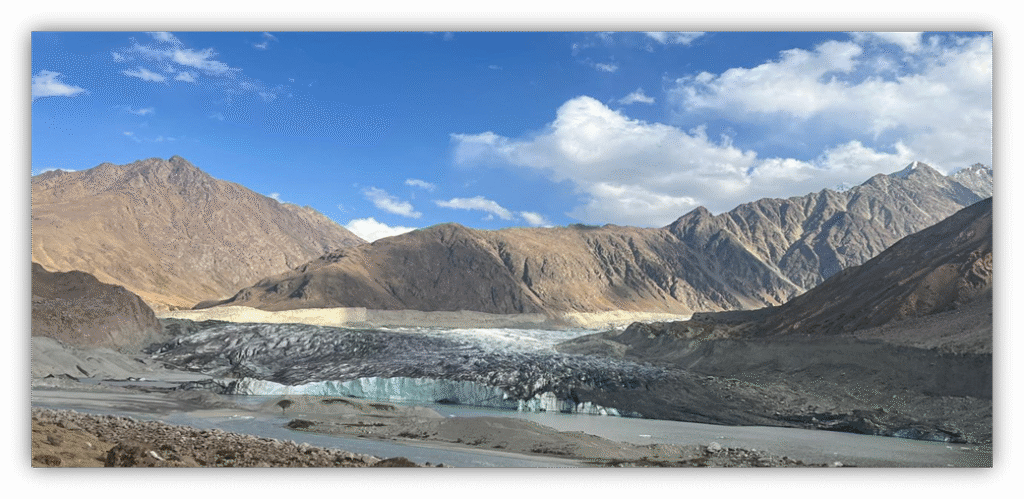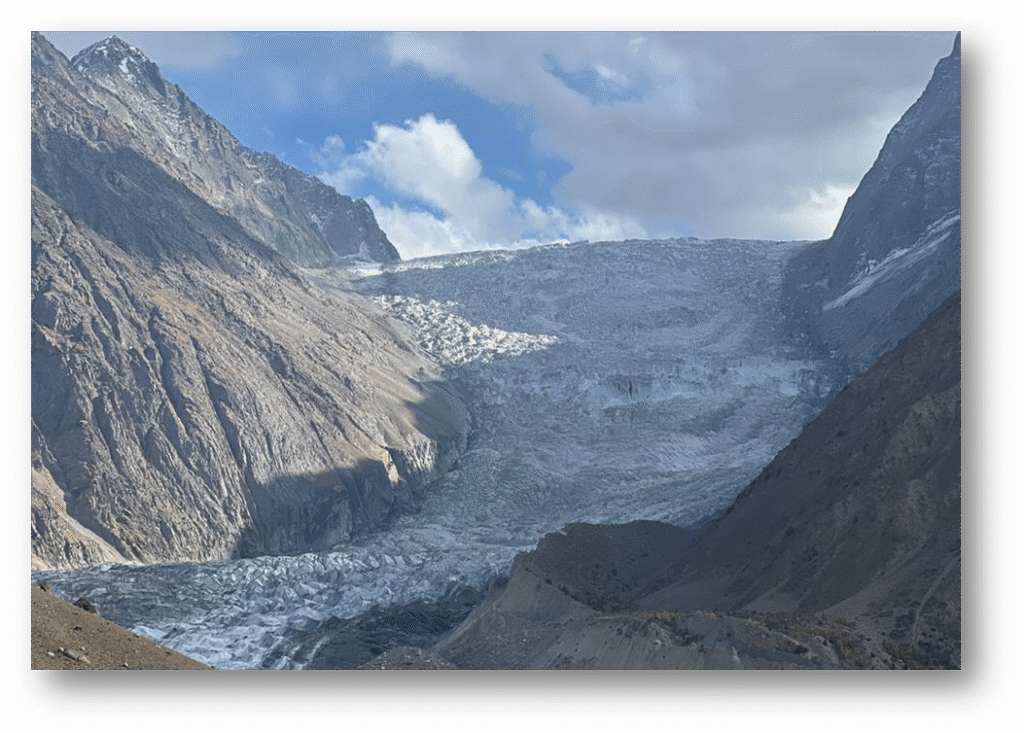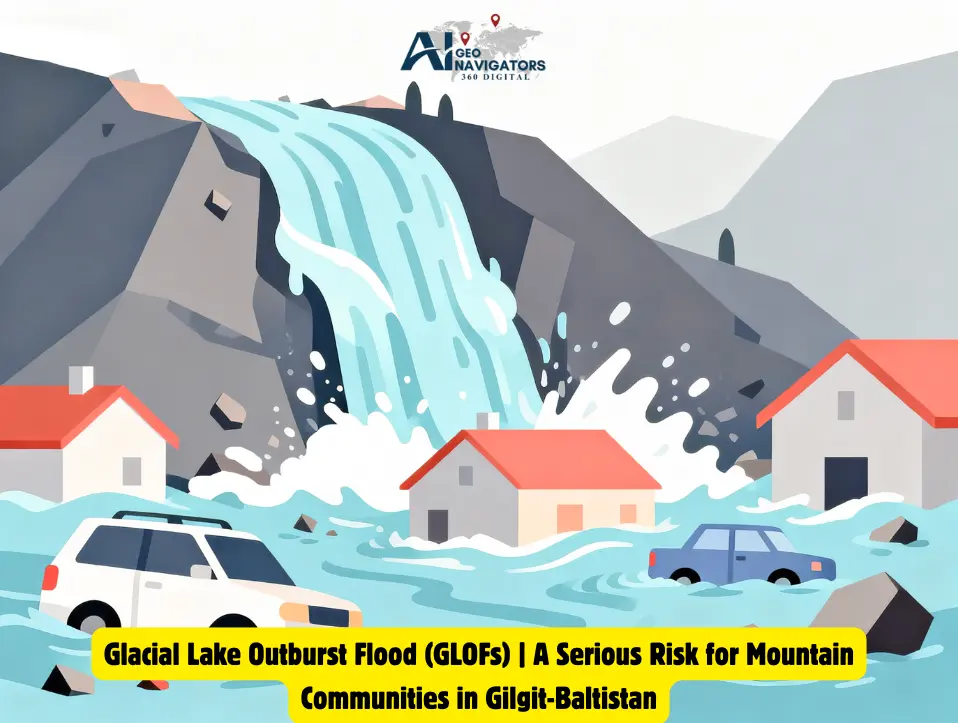Glacial Lake Outburst Floods (GLOFs) are threatening hazards in high mountain regions due to the rapid change in Earth’s climate. Glaciers are a natural source of freshwater in frozen form and are melting more rapidly today than at any time in recorded history. This rapid melting is the reason for the formation of new glacial lakes and expansion of existing ones.
Weak natural dams, loose sediments, and rocks often keep these lakes in check. When the dams break suddenly, a large amount of water starts flowing downstream, causing destruction within minutes and leaving communities with lifelong losses.
The HKH region is home to some of the largest ice reserves outside the polar regions. Gilgit-Baltistan stands out as a particularly vulnerable region where thousands of people live close to glacial valleys. According to the researcher reports and surveys, there are 3000-plus glacial lakes currently existing in Gilgit-Baltistan, and at least 36 lakes are confirmed as high threats due to their unstable conditions. Over the last two decades, several floods triggered by glacial lake failure have caused severe damage to infrastructure, irrigation systems, and local livelihoods.
The socio-economic impacts of GLOFs on remote mountain communities are significant. Most of the families rely on agriculture, livestock, and tourism as their primary income sources. When the flood destroys their homes and agricultural land, it takes years for them to recover.

The cryosphere, which includes glaciers and snow-covered mountains, plays an important role in stabilizing the global climate and supporting human life. In high mountain regions such as HKH, glaciers are a source of freshwater reservoirs. They slowly release meltwater into rivers, sustaining millions of people living downstream.
However, the alarming rise in global temperatures over two decades had troubled this delicate balance. Glaciers that once remained stable for centuries are now retreating rapidly, leading to the formation of many glacial lakes at their fronts.
A glacial lake forms when the meltwater accumulates behind a natural dam made of loose sediments. These lakes may appear calm and beautiful on the surface but can turn highly dangerous when the natural dam becomes unstable and weak. A sudden burst can release massive floodwater downstream, causing what is known as a Glacial Lake Outburst Flood (GLOF). Such floods are fast-moving, unpredictable, and extremely destructive.
In Pakistan, the region most exposed to this danger is Gilgit-Baltistan, with over 7,000 glaciers, making it one of the largest glaciated areas outside the Arctic and Antarctic. The research, remote sensing, and field studies indicate that more than 3,000 glacial lakes have developed in this area due to accelerated glacier melting. Out of these, 36 lakes are categorized as highly vulnerable, for sudden floods could occur at any time, without significant warning.

Over the past 20 years, several GLOF incidents have already impacted local communities. Roads, hydropower facilities, agricultural lands, and bridges near riverbanks have suffered repeated damage. For example, the 2022 Hassanabad GLOF illustrates how increased climate-induced glacier melting has heightened the risk of disaster in these regions.
This issue is not only environmental but also deeply socio-economic. Rural households rely heavily on agriculture, livestock and seasonal tourism. When floods destroy fields, water channels, families lose their primary source of income. The constant fear of floods results mental stress and sometimes forced relocation to safe areas. This creates long-term instability in the communities and after regional development.
Understanding how climate change affects glaciers and leads to GLOF hazards id very important for the safety of mountain communities. By improving scientific monitoring, building strong early warning systems, and increasing awareness among local people, we can greatly reduce the damages and looses caused by such disasters in the future.
GLOFs serves as a strong reminder from nature that if climate change continuous without control, the people living in high mountain regions, that livelihoods, and their natural surrounding could suffer damage that may never be prepared. Immediate action is essential to protect these vulnerable population living under the growing shadow of glacier-related hazards.
Causes of Glacial Lake Outburst Floods (GLOFs)
Glacial Lake Outburst Floods (GLOFs) occur when a glacial lake suddenly releases a large volume of water due to the failure of the natural dam holding it. These natural dams are mostly made of loose rocks and sediments known as moraines. Over time, as glacier melt and retreat due to rising temperature, meltwater begins to accumulate in depressions near glacier fronts, forming lakes that keep growing larger and deeper. When the pressure inside the lake becomes too high or the dam is triggered by an external force, it fails and results in a catastrophic flood downstream.
One of the most causes of GLOFs is rapid glacier melting. During warm season, the meltwater entering the lake increase faster than the outflow, raising water level and pressure against the dam. The situation is becoming more common in the Hindu Kush, Karakoram, Himalaya (HKH) regions, including Gilgit-Baltistan, because climate change is accelerating glacier melt at an alarming rate.
Another major trigger is ice avalanches and landslides from surrounding mountains. When large chunks or rocks or ice fall directly into a lake, they can displace water and create large waves. These waves hit the moraine dam and may push water over the top, leading to over toping and dam collapse. The Shisper Glacier surge in Hunza is an example where glacier movement created temporary lakes and raised the risk of sudden floods.
Earthquakes also increase the instability of lake dams. Gilgit-Baltistan lies in a seismically active zone, and even moderate earthquake can shake steep valley walls and weak moraine structures.

A hidden yet dangerous internal process is erosion inside the dam structure. As water leaks through weak moraine, it slowly forms underground channels. Over time, these channels extend, weaken the dam’s footing, and finally cause a sudden collapse. The kind of failure gives no noticeable warning signs, making it difficult to predict.
Climate change is the main factors behind all these causes. Rising temperature increase glacier melt, expends lakes, and intensify weather events. Without real monitoring and risk reduction planning, more lakes in Gilgit-Baltistan may become highly unstable in the coming years.
Socio-Economic Vulnerabilities in Mountain Communities
Hilly communities in Gilgit-Baltistan live in a uniquely challenging environment where geography, climate, and partial access combine to create high vulnerability to glacier induced hazards. While local people have lived with glaciers for many years, the increasing impacts of climate change have amplified risks beyond traditional copying capacity. Socio-economic vulnerability emerges from multiple interlinked factors, including poverty, livelihood dependence on natural resources, and infrastructure limitation.
Agriculture is the main source of local economies, yet farms are located along the rivers and debris fans areas are highly exposed to GLOFs and flash floods. A devastation of cropland due to a glacier-fed flood can push entire households into food insecurity within a single season. Another major livelihood asset, it also threatened by sudden hazards, especially during summer grazing in high-altitude meadows near glacier fronts.
Poor infrastructure increasing vulnerability. Many villages are depending on a single road for mobility and supplies. When a flood washes away a bridge or a road section, communities become isolated for weeks, hindering rescue, and healthcare. Housing structure built with local materials like stones and mud are not resilient to hazards likes debris flow.
Climate Change and Glacier Retreat
Global warming has noticeably accelerated glacier melt in the Karakoram and Himalayan regions. Although some glaciers in Karakoram exhibit the “Karakoram Anomaly” slow or neutral mass loss the majority of small and medium-sized glaciers in Gilgit-Baltistan are retreating at alarming rates. Warmer summer, reduced winter snowfall, and increasing frequency of heatwaves are key contribution to enhanced melt.
As glaciers shrink, glacial lake expands, creating unstable condition for moraine dams. When these dams fail, they release millions of cubic meters of water downstream within minutes, causing destructive GLOFs. Scientific studies indicate that the number and volume of glacial lake in GB have increased significantly over the past two decades.
Conclusion
Glacier-induced hazards represent one of the biggest challenges for socio-economic stability in Gilgit-Baltistan. As climate change rapidly changes the mountains, risk is increasing faster than communities can adapt. The most exposed population those with limited economic resources, high exposure, and adaptive capacity are paying the higher price.
A resilient future requires a shift from responsive disaster response to proactive risk reduction. Strengthening scientific monitoring, aware local communities, improving infrastructure standards, and developing alternative livelihoods are crucial steps.


No responses yet